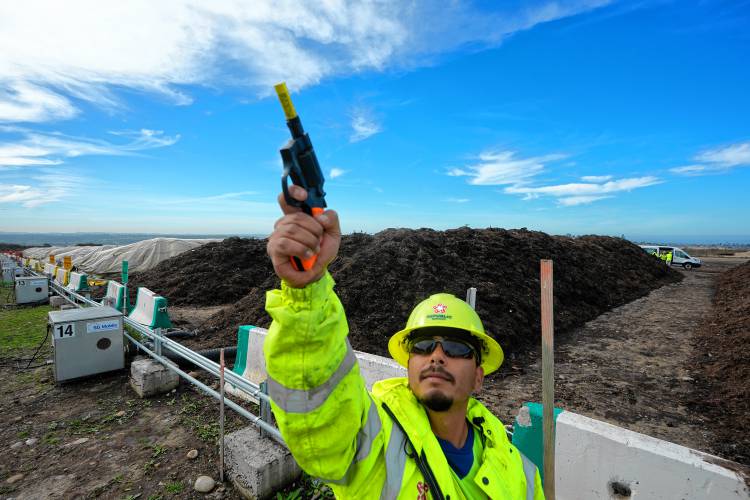My Turn: Crucial to eat into our massive food waste

A Republic Services operator shoots a blank into the air to keep wild birds off trash as compost mounds are being cured at the Otay Landfill in Chula Vista, Calif., on Jan. 26. The Otay facility is one strategy to keep organic waste out of landfills. AP
| Published: 03-21-2024 6:10 PM |
Roughly 35% of the United States’ total food supply ends up as food waste each year.
Let that sink in for a minute: For every 10 pounds of food that is grown, harvested, processed, distributed and then sold, more than three pounds end up getting thrown away or discarded. That adds up to around 1,000 pounds of food per person each year.
It’s not just that we could feed the hungry with that excess food — we could also better safeguard our environment. According to EPA, every year, the resources committed to wasted food include:
■Land: Over 140 million acres of agricultural land, an area the size of California and New York state combined.
■Water: 5.9 trillion gallons of fresh water, equivalent to the use of well over a third of all U.S. households.
■Energy: 664 terawatt-hours of energy, enough to power over 50 million average homes for a year.
■Our health: In our current agricultural system, it takes 778 million pounds of pesticides to grow food that is later wasted. These chemicals threaten pollinator and human health.
■Our climate: The production and decomposition of wasted food constitute 4% of annual U.S. greenhouse gas emissions.
Article continues after...
Yesterday's Most Read Articles
 Orange Selectboard declares armory as surplus property
Orange Selectboard declares armory as surplus property
 Sportsman’s Corner: Orange Gun Club’s Kids Derby
Sportsman’s Corner: Orange Gun Club’s Kids Derby
 Volunteers repaint Athol gazebo for veterans memorial service
Volunteers repaint Athol gazebo for veterans memorial service
 Battery storage bylaw passes in Wendell
Battery storage bylaw passes in Wendell
 Debt-burdened UMass students, grads rally for relief
Debt-burdened UMass students, grads rally for relief
 Committee forms to oppose psychedelics push in Mass
Committee forms to oppose psychedelics push in Mass
The task of eliminating billions of pounds of food waste may seem daunting, but many entities including farms and grocery stores, restaurants, schools, and hospitals have all taken action to reduce food waste.
As of 2022, Massachusetts regulations require commercial facilities that produce at least half a ton of food waste per week — think hospitals, colleges and universities, supermarkets, hotels, nursing homes, prisons — to redirect table scraps, withered fruits and floppy vegetables, and expired (but still perfectly edible) packaged foods toward food pantries, compost facilities, local farms, or to anaerobic digestion facilities rather than a landfill.
Many of those entities are using one or more of the following tactics:
■Tracking. Tracking food waste allows institutions to know if their waste reduction strategies are working. Boston Medical Center started weighing food waste in their kitchens prior to disposal.
■Planning production and inventory around demand. UMass Dining uses “Just-in-Time” cooking, preparing meals every 30 minutes, making it easier to adjust for demand.
■Reimagining new uses for conventionally discarded items. Browned fruit that may no longer look appealing on the salad bar, might work just fine in banana bread, apple crisp or other product.
■Embedding food donation into everyday practices. Local supermarket chain Big Y donates surplus food to area food banks on a weekly basis.
Adopting multiple mechanisms to divert food waste, emphasizing food waste education and stakeholder support, and exploring innovations can also make a big dent in making sure good food doesn’t get wasted.
Despite these efforts to curb food waste, Massachusetts is not on track with its goals. Food waste diversion rates need to double between now and 2030 to hit the targets set out in the Department of Environmental Protection’s Organics Action Plan. To get there, Massachusetts needs to invest in more frequent inspections of institutional waste, enforcement, and connecting entities to resources to help them reach food waste reduction goals. We need to move towards zero disposal of food waste.
Federal policy can help too and one needed reform is clearer labeling.
Aside from infant formula, food date labels are not regulated on the federal level, leaving myriad state laws and differing, opaque business practices that confuse consumers. At the store, consumers might find any number of different terms on food packaging — “sell by,” “best by,” “use by,” “freshest on,” “expires on,” and a handful of others. These dates are often not an indication of the food having gone bad. They are typically a manufacturer’s best guess as to when a product will have passed peak freshness. Research suggests nearly 10% of all wasted food gets thrown out because of confusion over how to interpret food date labels.
The Food Date Labeling Act, supported by a bipartisan group of lawmakers including our own Congressman Jim McGovern, would require standardized date labeling with separate phrases indicating whether the date is just a suggestion of peak quality (“BEST if used by”) or a different, consistent phrase (“USE by”) if there is an increased risk of food-born illness past a certain date. This one bill alone has the potential to eliminate nearly 800,000 tons of food waste every year.
You can show your support for the legislation by sending a message to your member of Congress here. And if you’re interested in learning more, you can RSVP to attend a webinar organized by MASSPIRG on March 21.
To reduce food waste, feed the hungry, and protect our planet and our health, it’s time to cook up more ways to reduce food waste.
Johanna Neumann of Amherst has spent the past two decades working to protect our air, water and open spaces, defend consumers in the marketplace and advance a more sustainable economy and democratic society. Janet Domenitz is the executive director of MASSPIRG.

